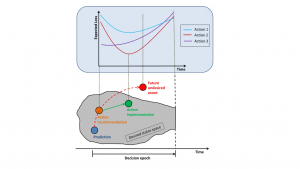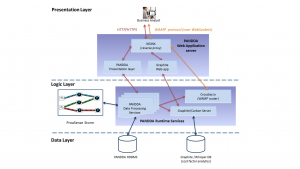
‘Sensing Enterprise’ refers to the ability of the enterprise to process information captured by sensors and to provide added value insights. Although sensing enterprises with high monitoring capabilities within their network and across different levels are a reality, the strategic value of data analysis can be increased by supporting data-driven decision making. Similar to the way that the events are driving reactivity in the sensing enterprise, predictions can drive proactivity, leading to increased situation awareness and decision making capabilities ahead of time. Proactive computing extends the reactive pattern known as ‘Sense-and-Respond’ or ‘Detect-and-Act’ to the proactivity principle consisting of four stages: Detect events and situations, Predict future events, Decide proactive actions, Act by enacting the decision taken in order to adapt the operational system.
PANDDA: ProActive seNsing enterprise Decision configuration DAshboard
PANDDA shifts decision making from early warnings into business performance optimization in the context of the digital enterprise. To do this, it incorporates novel information technologies and implements proactive decision making algorithms with the ability to eliminate or mitigate the impact of undesired future events, or to exploit future opportunities. On the basis of (near) real-time predictions about future failures that lay outside the “Normal states space”, PANDDA is enacted online in order to generate proactive recommendations, i.e. recommendations about optimal actions and optimal times of applying them.
In cases of future undesired events, PANDDA aims at minimizing the expected loss, while in cases of future opportunities, it aims at maximizing the expected utility. For an undesired event example, the expected loss is represented as a function of the implementation time. Therefore, t = 0 is the time when a prediction is received and a recommendation is provided. The expected loss functions are optimized within the boundaries of t = 0 and the time of the end of decision horizon. For example, for three alternative actions, the optimal action is Action 2 and the optimal time for its implementation is the time when the expected loss is minimized. In this way, the user gets a recommendation that minimizes the expected loss and provides them a time window until the recommended implementation time in order to be prepared appropriately.

The PANDDA implementation
PANDDA is a Python web-application developed using the web2py framework. The Presentation Layer occupies the top level of the architecture and displays information related to services available on the web-based PANDDA configurator. The Logic Layer controls application functionality by performing detailed processing. The two main functionalities of the PANDDA system are: (i) Proactive Decision Making, for generating recommendations about optimal actions and optimal times, and (ii) Sensor-Enabled Feedback (SEF), for performing continuous learning of the parameters that are inserted into the proactive decision making models by processing sensor-generated data. The Data Layer houses a relational database engine where the information needed by the main algorithms of PANDDA is stored and retrieved.

PANDDA was developed and evaluated in the context of the FP7 ProaSense project.
A demo video with the system walkthrough of PANDDA is available online: https://www.youtube.com/watch?v=Y8lbPT3jcvg.

